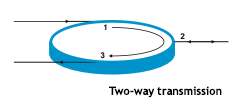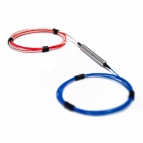Optical circulators of Fibrain Directivity family are passive optical devices, usually having 3 or 4 ports, that are used for switching signals between the ports in a given order. It is a way of achieving high directional isolation and low-loss transmission between specified pairs of ports. The most frequently used type of optical circulator is the 3-port version. It transmits the signal from port 1 to port 2 and from port 2 to port 3, blocking the transmission between other port pairs. The 3-port circulator is usually used for switching from a piece of link that uses bidirectional transmission in one fiber to a piece with standard bidirectional transmission in two fibers.
The circulators are available in versions optimized for 1310, 1490, 1550, 1590, and 1625 nm windows. They are delivered with a report containing attenuation and isolation values in the operation band and with labeled ports and direction of transmission.
- High channel isolation
- 1310, 1490, 1550, and 1590 nm operation windows
- Wideband versions for C+L bands
- Insensitive to polarization
- 3- and 4-port versions
- Different casing versions
- Delivered with test reports
- Wide range of available connectors
| Parameter | 3-port circulator | |
| Central wavelength | 1310,1490,1550,1590* | 1625 |
| Operating band |
Λc ± 30 nm |
|
| IL | ≤ 0.8 dB | |
| Directional isolation | ≥ 40 dB | |
| RL | ≥ 55 dB | ≥ 50 dB |
| PDL | ≤ 0.15 dB | |
| Max optical power | 500 mW | |
| PMD | < 0.1 ps | |
| Temp. of operation | from – 50C to + 750C | |
| Temp. of storage | from – 400C to + 850C | |
Notice: Parameters listed in the table refer to components without connector terminations
- Telecommunication networks
- Dispersion compensating systems
- Optical amplifiers
- WDM systems: ADD/DROP
- Metro systems
Optical circulators with output fibers with 250/900 µm coating have a 5.5x50 mm pipe casing with a serial naumber printed on the pipe with an indicated direction of transmission.
Additional possibilities:
- 90x20x10 mm black box housings for isolators with output fibers in 0.9/2.0/3.0 mm coating
- assembly in LGX modules, 19’’ panels, etc.

